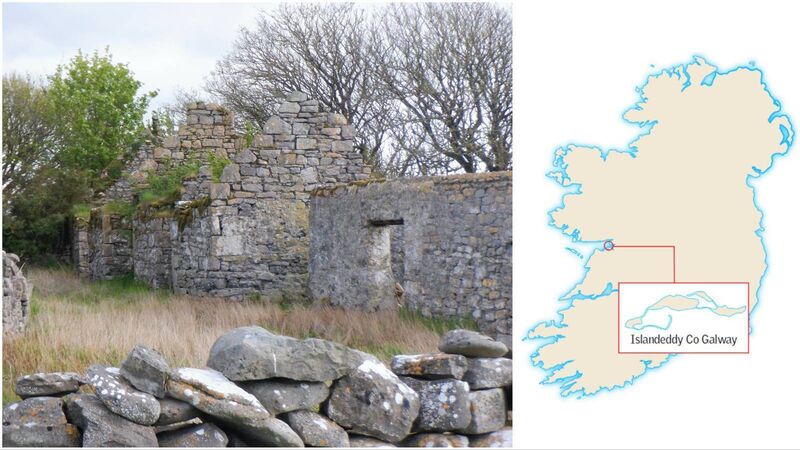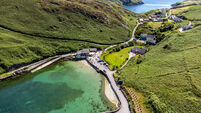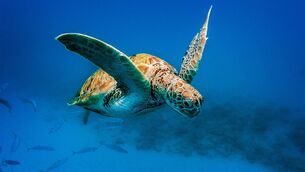Islands of Ireland: Galway's Islandeddy is gorgeous

Islands of Ireland: Islandeddy, County Galway. Picture: Dan MacCarthy
If the surrealist painter Joan Miró had been asked to design an island, Islandeddy in County Galway would surely have been it. With its swirls and curves, impossible loops, holes and bits that seem to not belong but do, this gorgeous island is so pleasing to the eye that it deserves to be hanging above the mantlepiece.
Its eastern end is dominated by a low-lying grassy plain separated from the larger part of the island by a huge lagoon whose southern side links the two large parts by a gravel bank. This pattern is duplicated further west with another huge gravel bank that doesn’t seem to know what to do with itself, deposited as it was by the whims of the tides.
On a visit on the first day of summer a fortnight ago, the island was teeming with birdlife: Curlew, pipits, oystercatcher, gulls, terns, bullfinch, and swallows to name but a few, swerved, dipped, glided or merely posed on a fencepost as the avian kingdom laid on a visual and auditory display to die for.
Islandeddy or Oileán Eide bears no relation to the village in County Mayo, Islandeady, which has a different origin. It has had several versions of its name including Olyneady in 1585, Iland Ide in 1617, and Island Edye in 1660.
There are the flimsiest remains of an old castle on the northern shore now crumbling almost beyond identity. The island’s population peaked at 125 people in 1841. Predictably, the Famine decimated the population to 66 post-Famine, and a steady decline set in thereafter. Numbers did climb back to 77 by 1881 but then declined again. By 1951 it was down to 16 people and by 1981 nobody lived there. There is also a children’s burial ground near the castle. Nothing too strange in that, as they occur on many islands.
CLIMATE & SUSTAINABILITY HUB
The island had a school too with the last teacher a Kathleen Finnegan. The school had been built by TC Redington who owned the island and who was regarded as a reforming landlord. In 1846 he was named as under-secretary for Ireland and advocated for a moratorium on rents to help distressed farmers.

The names of some of the islanders in the 1911 census include: Bermingham; Conlon; Corles; Hynes; Kane; Keane. But they have all gone, swept away by the tide of time. Most of the houses are now roofless but telling signs of past habitation persist. Old farm machinery lies rusting in the nettles. Fuchsia is draped across an old gate, grey crows roost in the chimney stacks and an obvious road traverses the island east to west.
The Osi map for that period attests to this density with 39 buildings evident, though some of these would have been for farming purposes. Today, two of the houses on the 65-hectare island have been restored for holiday home use with the tricolour flying proudly from one.
The land on the island is good for growing crops but not as good as the valuation in 1926 had it, a situation which led to a major dispute with the islanders. In the Dáil, Sean Broderick TD spoke up for the islanders by stating the valuation exceeded the best land in County Galway. This fell on deaf ears as the sheriff of the county with bailiffs and a military escort landed on the island to seize property in lieu of payment and to “bring the defiant islanders to heel’ as one newspaper reported. But the paper reported that the islanders were victorious in the end as the government capitulated.
And though not a village in name, with 125 people once living there cheek by jowl, it was a village. Now deserted, as in Oliver Goldsmith’s famous poem, ‘The Deserted Village’: “Sunk are thy bowers, in shapeless ruin all, And the long grass o'ertops the mouldering wall;
And, trembling, shrinking from the spoiler's hand, Far, far away, thy children leave the land.”
: No ferry. Kayak from a pier 1.5km directly west of the island
: logainm.ie; dib.ie
- Considering the month that is in it, — May is Sustainability Month in the Irish Examiner — this column pledges to remove a bag of plastic where possible from each island visited for the rest of the month. Actually, for the rest of this series. Start as you mean to go on!










